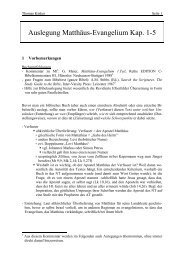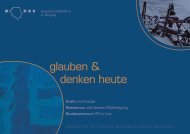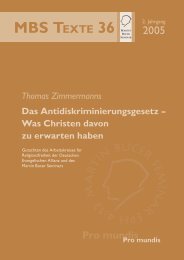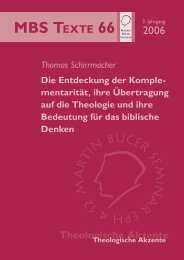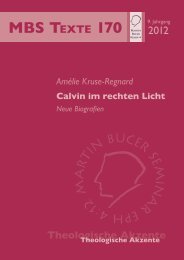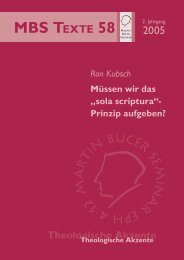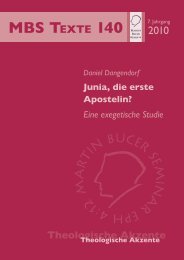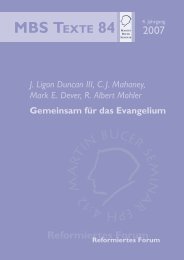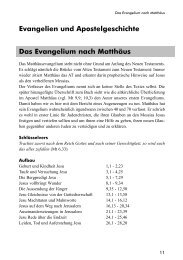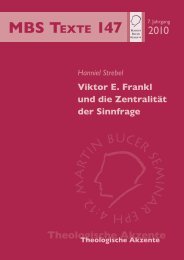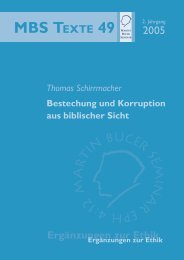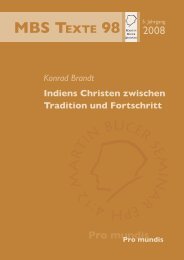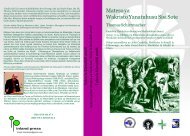You also want an ePaper? Increase the reach of your titles
YUMPU automatically turns print PDFs into web optimized ePapers that Google loves.
MBS Texte 1487. Jahrgang2010George M. Ella<strong>John</strong> <strong>Durie</strong> (1596–1680):Defragmenter of theReformationMARTRIN BUCER S EMINAR EPH 4:12Reformed ForumReformiertes Forum
Table of ContentsInhaltsverzeichnisPart One: Europe and Britain Working Together...................... 3Part Two: Ideas of Union Grow................................................. 8Part Three: Working for Cromwell.......................................... 14Annotation.............................................................................. 20The Author.............................................................................. 21Impressum.............................................................................. 221. Aufl. 2010
<strong>John</strong> <strong>Durie</strong> (1596–1680): Defragmenter of the Reformation<strong>John</strong> <strong>Durie</strong> (1596–1680):Defragmenter of the ReformationGeorge M. EllaPart One: Europe andBritain Working TogetherWho on earth is <strong>John</strong> <strong>Durie</strong>?Most computer users have experiencedhard disks full of jumbled, fragmentedfiles which block spaces causingmemory and retrieval problems. Whata relief it is to switch on a defragmenterand have everything made ship-shapeagain. The Reformation in mid-seventeenthcentury Britain had reached sucha fragmentation and a defragmenter wascalled for. The man for the job was certainly<strong>John</strong> <strong>Durie</strong> who was possibly themost well-known man in Europe at thetime and one whom countless crownedheads, church leaders, politicians, generals,educators, social reformers andhumble men and women loved andrespected. If anybody, he was the oneto knit together again what denominationalism,legalism, rationalism, politicalstrife, opportunism and personalambition had rent asunder.“Who on earth is <strong>John</strong> <strong>Durie</strong>?” youmight well say; “Never heard of him!”.This common ignorance is one ofthe tragedies of our present confusedchurches. Britain has forgotten anotherof her greatest Christian heroes. Whereis the modern man of God today whois world-renowned as a great preacher,pastor, diplomat, educator, scientist, linguist,translator, man of letters, ambassador,library reformer, mediator andpolitician? Who today produces bestsellerson a monthly basis, writing inhalf a dozen different languages? In allthese fields <strong>John</strong> <strong>Durie</strong> has been called‘great’ or ‘the greatest’, yet he is forgottenby his mother country whom heserved so long and well. This is perhapsbecause it is beyond human imaginationthat such a man could have existed andhis ‘type’ today is not called for. Trevor-Roper, speaking of the great deeds of<strong>Durie</strong> and his colleagues in his Crisisof the Seventeenth Century says ‘the needproduced the men’. Does it? We are insuch a ten-fold need today but whereare the men? Yet, <strong>Durie</strong>’s idea of a pan-European Reformed Church based ona reformation of church life and educationwas supported by the majorityof Reformers and Puritans from Elizabeth’sdays to post-Restitution times.<strong>Durie</strong> was supported by Charles Iand Oliver Cromwell, besides most ofthe crowned heads of Europe and theleaders of the various republics andSwiss cantons. Reformed Bishops andArchbishops Hall, Davenant, Morton,Reformiertes Forum 3
George M. EllaBedell, Abbott and Ussher backed<strong>Durie</strong> and even Laud promoted <strong>Durie</strong>’splan of Protestant unity in Europe witha surprising degree of enthusiasm as hisletters show. Later, the Commonwealthparliaments and the WestminsterAssembly fully supported <strong>Durie</strong>’s enterprise.Indeed, <strong>John</strong> <strong>Durie</strong> was made amember of the Westminster Assemblyand Britain’s ambassador-at-large toEurope chiefly because of his lead inpromoting a pan-European Protestantunion and his great proficiency as a linguist.Cromwell is famed for his internationaldiplomacy but without <strong>Durie</strong>’shelp, Cromwell would never have beentaken seriously in Europe for a numberof reasons. Indeed, when Charles’ headfell, most of the Continental kingdomsand dukedoms broke with England.It was largely due to <strong>Durie</strong>’s frequentdiplomatic tours of the Continent thatrelations bettered. Thus when JamesReid in his excellent Memoirs of theWestminster Divines, introduces <strong>Durie</strong>as: ‘A Scotchman, and learned Divine,who was eminently distinguished byhis indefatigable industry to promoteunion among Christians, and a memberof the Assembly of Divines at Westminster’,he does not reveal a fraction of<strong>Durie</strong>’s value to Britain.An exile Scotsmanbecomes a leader in Europe<strong>John</strong> <strong>Durie</strong> was born in Edinburgh in1596 of a long line of ministers, diplomats,lairds and rebels. His grandfatherof the same name worked with Knoxand Melville as pastor of St. Giles, Edinburgh.He was banished twice by theKing but ended his life on a royal pension.<strong>John</strong>’s father, Robert <strong>Durie</strong> was anex-monk and Presbyterian minister inAnstruther, Fife, who had evangelisedLewis, the Orkneys and the ShetlandIslands. After a short prison sentenceand growing differences with James VIwhich led him to extreme measures, hewas found guilty of treason and exiledin 1606. He and his young family founda new home in Leyden, Holland. There<strong>John</strong> was educated in French, Dutch,German, and Latin and matriculated intheology aged 15 at Leyden Universitybefore doing further studies in Sedanunder his cousin Andrew Melville.Other sources say that <strong>Durie</strong> finishedhis studies at Oxford because of thegreat libraries there. It is said that when<strong>Durie</strong> travelled anywhere in Europe,he would adopt the clothing and languagesof the various countries andalways be taken for a native. He evenadapted his own name to suit the locallanguage being known on the Continentas Johannes Duraeus and at leastfive other variants.Now twenty-five years of age, <strong>Durie</strong>became a private teacher for twoyears in France, coaching the son ofBarthelemy Panhausen, a Huguenotmerchant. Then <strong>Durie</strong> was called topastor the Belgic church in Colognefrom 1624–1626 where he preached inFrench, Dutch and Latin. <strong>Durie</strong>’s greattalents as an internationalist reachedCharles I’s ears and he was asked toaccompany Ambassador Extraordinary,4MBS Texte 148
<strong>John</strong> <strong>Durie</strong> (1596–1680): Defragmenter of the ReformationLord James Spence on his Swedish journeyto make Gustav II Adolf a knightof the Order of the Garter. <strong>Durie</strong> wasaccepted gladly by the Swedish Courtand leading ministers and gained lifelongfriends.King Gustav decided to make Elbingin West Prussia the capital of his German-Polishterritories and <strong>Durie</strong> wascalled in 1624 or 1625 to pastor themulti-national church there, originallyfounded by Scottish and English merchants.<strong>Durie</strong> found himself ministeringin several languages again, nowincluding Lithuanian. Because of thedifferent church backgrounds involved,he pastored ‘ecumenically’ but basedon the sound doctrines of the Reformation.Having qualms about notbeing ordained, he corresponded withBishop Joseph Hall of Dortian fame onthe subject. At this time Sweden hadgone through a real indigenous Reformationso they did not feel obligedto accept any other major EuropeanReformed Creeds whether Lutheran,Reformed or Anglican. They did, however,instruct their theological studentsin Melanchthon’s Confessio AugustanaVariata of 1540. This version toneddown consubstantiation so much that itwas accepted by both Calvin and Beza,leaving the Frenchmen less Reformedthan the Church of England Reformerswho followed Bullinger’s interpretationof the Lord’s Supper. The Book of Concordwas not even on the curriculum.So, Michael Dewar is incorrect in sayingthat the Swedes held ‘tenaciouslyto the doctrine of Consubstantiation’. 1A small Gnesio-Lutheran faction campaignedfor a full acceptance of theLutheran formulas but there was astronger Reformed group amongst theSwedish middle-class, a large group ofReformed Waldensians immigrants anda number of Greek Orthodox on theborders of Sweden’s Baltic Empire, eachwith their own views of the Lord’s Supper,so no one view prevailed. A recentchat this author had with ArchbishopAnders Weyryd concerning Cromwell’sefforts for church union with Swedenconfirmed that, even today, the StateChurch in Sweden allows local churchesfreedom in expressing faith rather thanenforces nation-wide strict rules offaith and order. It must be added thatnot even the German Lutherans stoodunanimously behind the Book of Concordwhich became a Book of Discordfor many. 2Gustav Adolf also set up his HighCourt at Elbing and the new seniorjudge and Privy Councillor, KasparGodemann, who had recommended<strong>Durie</strong> as pastor to the King, was afervent Reformed Unionist. Gustavcalled English statesman and ReformedChristian Thomas Roe as ambassadorto mediate in the Swedish-German-Polish peace treaties. Roe soon told<strong>Durie</strong> that he, too, desired a strongerpan-European church and politicalunion based on a common Reformedstand against Rome. Roe felt this unioncould stretch as far as Turkey as he hadbeen successful in gaining an ear forReformed doctrine during his ambassadorshipthere. A further resident ofReformiertes Forum 5
George M. EllaElbing, Samuel Hartlib, who was tohelp reform England’s schools and agricultureunder Cromwell, also shared<strong>Durie</strong>’s views. Some time later, <strong>Durie</strong>’sand Hartlib’s friend and co-worker<strong>John</strong> Amos Comenius, the internationallyfamous Reformed theologianand educator, settled in Elbing, so formany years the city became the centreof international political, religious andeducational reform.<strong>Durie</strong>, Roe and Godemann beganto work out a programmed strategy forinternational cooperation on the basisof the Reformed faith and <strong>Durie</strong>’s twonew friends begged him to resign hispost at Elbing and solicit the EnglishCourt, Church and Parliament tosend him out as England’s negotiatorin Europe for ‘the procuring of trueGospel Peace, with Christian Moderationand Charitable Unity amongst theProtestant Churches and Academies’.Godemann felt that <strong>Durie</strong> was just theman to bring unity between the Germansand the Swedes and then bringin the other European countries. Roethought that <strong>Durie</strong> could be very influentialin settling disputes between Episcopaliansand Presbyterians in Britainand strengthening Britain’s close tieswith Europe. Thus, armed with recommendationsfrom Roe who representedBritain and Godemann who representedthe vast territories conqueredby Sweden, <strong>Durie</strong> returned to Britain,wondering how he would be acceptedbecause of his family history. He neednot have feared. Charles, was thankfulfor <strong>Durie</strong>’s diplomatic services inSweden and Germany and ArchbishopAbbot was immediately captivated by<strong>Durie</strong>’s charm, faith and great sincerity.Both authorised <strong>Durie</strong> to representBritain as ambassador to Europe in theinterest of ecumenical peace. He wasequipped with a limited budget, diplomaticpassports and recommendationsfrom leading politicians and clergy.On the Scottish side, ties withSweden at this time could hardlyhave been stronger as Gustav Adolfrecruited armies from Scotland and agood number of his senior officers andadvisors were Scotsmen. Throughoutthree reigns, <strong>Durie</strong> kept the Scottishchurches and Assembly up to date onhis mission of peace.Plans for union mature<strong>Durie</strong> spent most of 1631 in Englandand published his InstrumentumTheologorum Anglorum and Problematade Pacis Ecclesiasticae to which hisReformed supporters such as RichardSibbes, <strong>John</strong> Davenport, Samuel Ward,Richard Holdsworth, Philip Nye, <strong>John</strong>White, Cornelius Burgess, ThomasEdwards, Thomas Goodwin, DanielFeatley and Joseph Hall subscribed.Even Bishop Laud added his signatureto a covering letter from ArchbishopAbbot recommending the Instrumentumto the German and Dutch churches.Roe provided a covering letter to Oxenstierna,the Governor of Sweden’s conqueredterritories. Whilst still in England(March, 1631), the news reached<strong>Durie</strong> that the Reformed and Lutheran6MBS Texte 148
<strong>John</strong> <strong>Durie</strong> (1596–1680): Defragmenter of the Reformationprinces at the influential Leipzig Colloquyhad agreed to work together onlines suggested by <strong>Durie</strong> and wishedfor him to return to Germany. Thiswas mainly through the efforts of Prof.Johannes Bergius of Frankfurt-on-the-Oder who swore he would never restuntil Europe had one united Protestantchurch. Bergius, chaplain to the Brandenburgcourt, was a great contenderfor Reformed principles and turneddown an invitation to the Synod ofDort because he felt that the Dutch andGerman Puritans had departure fromthe Reformed faith. He had no qualms,however, about supporting the Englishdelegates and <strong>Durie</strong>. Bergius askedlearned Joseph Mede to aid <strong>Durie</strong>, butthe latter, already a Unionist supporter,answered, ‘From his wisdom and abilitiestherein, I am fitter to receive knowledgeand instruction than to censure orgive direction.’ 3 Naturally the princes atthe Colloquy had also a political aimin promoting Unionism. They wishedto give Protestant Germany a stronger‘third-party’ bargaining position withSweden and the Roman Catholics. Thiswas necessary for Germany’s own selfrespectas for the next thirty years or so,Sweden counted herself as the pivotingcentre of what they called their GermanKingdom with the right to rule her. TheRoman Catholic Emperor made thesame claims but at a safe distance.The academy of Sedan on the French,Belgium and Luxemburg borders nowpromised their cooperation and <strong>Durie</strong>found at first a cautious, then a stronginterest at Zürich where he was givensubstantial financial support by thecity. Thereafter, Protestant Switzerlandbecame <strong>Durie</strong>’s chief supporter.<strong>Durie</strong> now felt that the time wasripe for concrete action as Oxenstierna,the Marquis of Brandenburg and theDuke of Hesse had enough pan-Europeaninfluence between them to workout a permanent union with Britain.Their union, they claimed, had alreadybeen cemented in 1620 through themarriage of King Gustav to Maria Eleonoraof Brandenburg. <strong>Durie</strong> was nowinvited to diets and convocations heldin Hessen-Kassel, Hanau, Wetterau,Palatine, Heilbronn and Darmstadtand found his proposals backed bythe Swedish and German political andreligious authorities wherever he went.Frankfurt also voted to move towardschurch union. Brandenburg, the Palatineand Hessen-Kassel ruled to call aconference between the various denominationsto take definite steps towardsa common Reformed statement offaith. At the Heilbronn Conferencein 1633, all the delegates from all thenon-Roman Catholic churches voted toadopt <strong>Durie</strong>’s plans for union and thiswas the case in Mainz and Darmstadtwhere Sweden still held the reins. However,the Lutheran universities, with theexception of Helmstedt still opposed<strong>Durie</strong>’s plans.Helmstedt, the great centre of Reformationlearning in Germany, was radicallyinfluenced by Unionist GeorgeKallisen or Callixt (1586–1656). Heangered the Gnesio-Lutherans byrejecting the Book of Concord and theReformiertes Forum 7
George M. EllaLutheran dogma of ubiquity. Thisbecame the official stance of Helmstedtin its debates with the Gnesio-Lutherans, the Swedish Reformed andthe Roman Catholics. The Helmstedttheologians developed a balanced theologysimilar to that of the pre-RebellionChurch of England as an alternative toGnesio-Lutheranism and the legalisticpost-Reformed churches of the Heidelbergschool.<strong>Durie</strong> was received twice by GustavAdolf at Würzburg who promisedto give him letters of introduction tofurther Protestant rulers and churches.Gustav was killed at the Battle of Lützenbefore he could fulfil this promise.Sweden’s Secretary of State Spence(another Scotsman) and ChancellorOxenstierna, however, continued togive <strong>Durie</strong> full support. Gustav introduced<strong>Durie</strong> to his two chaplainsJacob Fabriius and Johannes Matthiaewho were quickly won over to<strong>Durie</strong>’s cause. When Matthiae becamePrincess Christina’s private tutor andchaplain, he influenced her in takinga keen interest in plans for unity.<strong>Durie</strong>’s correspondence with the SwedishRoyal family and government andMatthiae’s correspondence with manyof the Unionists are still extant andopen to researchers in the Uppsala andStockholm archives. The full story ofthis correspondence and its subsequentenormous impact on the developmentof Europe, including England has stillto be told. Sadly, in 1632, shortly afterpromising <strong>Durie</strong> that Sweden wouldaccept his plans, Gustav was killedin the Battle of Lützen. The SwedishEmpire was left to be ruled by youngChristina, born 1626 and educated as aUnionist, and the extremely competentLord High Chancellor Oxenstiernawhose first duties were political ratherthan religious. <strong>Durie</strong> realised he mustreturn to Sweden as soon as possible.Part Two:Ideas of Union GrowNew terms under a new Archbishop<strong>Durie</strong> had to postpone plans to visitSweden as in 1633 Archbishop Abbotdied and <strong>Durie</strong> was called from Germanyto report to the King and WilliamLaud, the new Archbishop. Onhis way to England, <strong>Durie</strong> foundan eager interest in Reformed unionamongst the Dutch. Ever since becomingchaplain to the Earl of Dunbarin 1608, Abbott had campaigned forchurch union between all ReformedChurches whether Episcopal or Presbyterian.His policy was to leave Englandas James found it and leave Scotland asJames left it but with the two churchesjoining hands in Reformed fellowship.Laud envisaged a merging of Continentalprotestant churches around thestandards of the Thirty-Nine Articles.The author of A Romish Recusants Lifeof Archbishop Laud, argues that Laudwanted to make himself a protestantpope to rival the papist pope. Luther,Westphal, Calvin, Beza and Cromwellall had such dreams. Abbott had thus8MBS Texte 148
<strong>John</strong> <strong>Durie</strong> (1596–1680): Defragmenter of the Reformationblocked Laud’s proposals for a Scottish-Englishchurch union from 1606to 1633. When Laud took over, herevoked Abbot’s church-union strategy.It was thus a very anxious <strong>Durie</strong> whoreturned to England. Laud has had amost negative write-up recently, especiallyby neo-Presbyterians who forgetthat many of the Westminster Divineswere trained, mentored and ordainedby Laud and his like-minded bishopsand furthered his politico-ecclesiasticalpolicies during the Commonwealthperiod. They merely rejected whatwas least harmful in him: his Episcopalianism.Many a Commonwealthrebel looked to theological heroes suchas Thomas Cartwright and TheodoreBeza who campaigned for unity basedon doctrines and orders of worshipless Reformed than the Thirty-NineArticles, the Irish Articles and theReformed Prayer Book, i.e. the doctrinesto which Laud held. In spite ofhighly contradictory opinions, MichaelDewar is historically correct in statingthat Laud gave <strong>Durie</strong> ‘every support’,praising his work in the most glowingtones. 4 Laud wrote to Ambassador Roeinforming him that the matter of unionwas so good a cause that if it failed, itwould not be for lack of his support.Laud’s method of financing <strong>Durie</strong> wasnot the best. He gave <strong>Durie</strong> a livingin Devonshire to provide him with anadequate income but <strong>Durie</strong> protestedthat this was no good as he lived mostlyabroad. <strong>Durie</strong> followed Laud’s adviceto appoint a curate but paid him a fullminister’s stipend so there was little leftfor himself. There were other minorobstacles. Laud told <strong>Durie</strong> that in orderto represent the Church of England,he must be ordained. <strong>Durie</strong> had beenconsidering ordination for several yearshimself so he accepted Laud’s adviceand was ordained by Unionist BishopJoseph Hall. Charles made <strong>Durie</strong> aroyal chaplain and ambassador toEurope’s courts, 5 but would not hear ofchurch agreements without their governments’backing. Now, <strong>Durie</strong> had,with some restrictions, the Archbishopand King behind him; many leadingpoliticians; some forty major ReformedBritish churchmen; most of the EuropeanProtestant royalty and manymajor Continental church leaders. TheContinentals proved more ready thanEngland to support <strong>Durie</strong> financiallybut we read now and then of Irish andEnglish bishops sending him smalldonations.Back on the Continent in 1633/34,<strong>Durie</strong> and Comenius were able to unitethe Reformed and the Bohemian Brethrenin Poland. Though many northerndukes were Gnesio-Lutheran, in1633–35 <strong>Durie</strong> gained the backing ofDuke Frederick Ulrich of Brünswick-Lüneberg who had studied at Helmstedtand Duke August his successor.August’s name has gone down in historybecause of the famous WolfenbuttelLibrary which <strong>Durie</strong> helped plan.Then <strong>Durie</strong> took part in the Synodof Utrecht in April 1636 and won thebacking of the pro-Augsburg ConfessionLutherans and the ReformedChurch who voted to merge. At theReformiertes Forum 9
George M. EllaSynod, <strong>Durie</strong> met Comenius’ son-inlawPetrus Figulus Jabvlonski of Bohemiawho became <strong>Durie</strong>’s private secretary.Jabvlonski was of great assistancein helping <strong>Durie</strong> produce books all thespeedier.New problems in SwedenIn 1636 <strong>Durie</strong> was free to returnto Sweden, staying there two years.He quickly consulted with the Royals,churchmen and the theologians atUppsala university. Uppsala presented<strong>Durie</strong> with eight conditions for unitywhich <strong>Durie</strong> accepted. Whatever <strong>Durie</strong>said or wrote was published in Uppsalaor Stockholm, including letters sent tohim with his replies, which caused criticism.Many insisted <strong>Durie</strong> should jointhe Swedish Church before attemptingto reform her orders. They said hecould not be a member of more thanone church, i.e. denomination, at once.<strong>Durie</strong> looked on his own ordination asa missionary authorisation to preachsalvation and to shepherd flocks everywhereas an ambassador for Christ. Hethus had little sympathy with denominationalshackles. He had expectednothing but red carpets in Sweden,but Sweden was only a single state ina vast empire of states, each with theirown ideas. <strong>Durie</strong>’s greatest problem wasthat now Gustav, ‘The Lion of Protestantism’was gone, there was no singlespokesman with whom <strong>Durie</strong> couldcooperate. Each church district or separatedenomination insisted on bargainingwith <strong>Durie</strong> themselves. Agreementsleading to church union could not beadministrated at the level of internationallaw but on the initiative of aninfluential group of supporters. Whenthese died, shifted their allegiance,or the political situation altered, suchplans were often dropped. Thus dangerwas illustrated by the 1634 Councilat Frankfurt. Oxenstierna arrived ina coach, making the German nobilityappear on foot to demonstrate Sweden’spower. This caused some animosity but,nevertheless, <strong>Durie</strong> won the majorityfor his plans. However, on 6. September,before the conference ended,Nördlingen fell to the Emperor andFrance entered the Thirty-Years Warwhich became so bloody that thoughtsof church unity were dismissed becauseof the seriousness of the situation.Obtaining food and clothing andretaining one’s life became major priorities.Roe had already found out howfragile success could be when dealingwith Patriarch Kyrillos Lukaris. Kyrilloswas born in Crete; had studied inEurope; was very open to Protestantideas and a firm contender againstRome. By 1620, he had gathered a largecircle of like-minded men around himand Roe supplied him with printingmachines and Greek type from Englandin order to publish and circulateKyrillos’ Reformed Confessio Fidei.This ran through several editions, wastranslated into several languages andwas strongly supported by the Swedishauthorities and the Church of Englandvia the Dutch Ambassador CornelisHaga; Sweden’s agent Paul Strassburg10MBS Texte 148
<strong>John</strong> <strong>Durie</strong> (1596–1680): Defragmenter of the Reformationof Nürnberg and England’s ThomasRoe. Gustav Adolf and Chancellor AxelOxenstierna corresponded with Kyrilloswhose influence was now spreadingthroughout the Greek Orthodoxrealms. Kyrillos thanked Sweden andEngland for their help by presentingGustav II and Charles I with ancientBiblical manuscripts. However, whenRoe left Turkey for Prussia in 1629 andthe Swedish King died in 1632, oppositionagainst Kyrillos grew and he wasremoved from office in 1635. Haga stillsupported Kyrillos who was enabled tobring out a Greek New Testament inboth Biblical and modern Greek in1638. Hopes of a Reformed EasternChurch were brought to a standstill inthe same year when Kyrillos was murderedby his opponents.Sweden v. FinlandThe rivalry between the Swedish andFinnish theological faculties preventeda speedy union. Swedish Uppsala andFinnish Åbo seldom agreed. WheneverUppsala appeared too ‘Calvinistic’, Åbosuddenly became Gnesio-Lutheran andvisi versa. The problem was that neitherfaculty had a fixed confessional basis.Theology professors either ignored allformulas or requiring their studentsto be merely familiar with them. Eachdiocese had different theological traditions,Strängnäs, for instance, rarelyagreed with Vesterås, They nurturedtheir different peculiarities and senseof piety which produced ideas thatwere neither Lutheran nor Reformedbut very much ‘Swedish’ or ‘Finnish’.By 1638, however, discussions concerning<strong>Durie</strong>’s views became so intensethat Queen Christina’s advisers forcedher to published a decree on 7th February1638 stating that <strong>John</strong> Duraeushad offended the peace of the Churchand must leave the country. <strong>Durie</strong>, nowbecame very ill, worn out with years oftravelling, frustrated plans and poorhealth and received permission to stayin Sweden until his recovery in Augustof the same year. He left Sweden forDenmark and then toured his Continentalconnections before accepting theposition of Court Preacher to Williamof Orange and Charles I’s daughterMary at their palace in the Hague in1641. However, Swedish events soonchanged. Christina became Chancellorof Uppsala University and managedto persuade Oxenstierna’s protégé Åboto accept her unionist ideas and effortswere made to set up training collegesin Germany on a unionist basis. Onthe other hand, some politicians werefrightened that if Sweden followed<strong>Durie</strong>, they would lose control of Saxonyand the Gnesio-Lutheran states.Hetherington’s alternative historyAmong <strong>Durie</strong>’s numerous workson unity printed in 1641 are A Memorialconcerning Peace Ecclesiastical: Tothe king of England and the pastorsand elders of the Kirk of Scotland meetingat St. Andrews” and Petition to theHonourable House of the Commons inEngland now assembled in Parliament.Reformiertes Forum 11
George M. EllaThese documents led to <strong>Durie</strong> beingproposed as a member of the plannedWestminster Assembly because of hisContinental Unionist activities. Thesewritings and especially <strong>Durie</strong>’s addressto the General Assembly of the ScottishKirk on unity, help debunk themyth fostered by W. M. Hetheringtonin his History of the Westminster Assemblythat, “This truly magnificent, andalso truly Christian idea, seems to haveoriginated in the mind of that distinguishedman, Alexander Henderson.” 6Henderson, according to Hetherington,passed the idea on to the ScottishCommissioners who then persuadedthe Westminster Assembly to acceptit and ask the Continental churches tojoin them. As evidence, Hetheringtonadds an appendix to his work entitledOur Desires Concerning Unity in Religion,and Uniformity of Church Government,As a Special mean to ConservePeace in His Majesty’s Dominions. Thishe ascribes to Henderson, claiming thatit was sent to each foreign country in1543 with a copy of the Solemn Leagueand Covenant attached.Hetherington’s view has no historicalbasis and ignores <strong>Durie</strong>’s long and closeconnections with the Scottish Presbyterians.Hetherington presents <strong>Durie</strong>as first allying with Westminster pleasfor unity towards the end of 1543, overtwo years after Henderson allegedlybroached the theme and over a decadeafter <strong>Durie</strong> himself campaigned forsuch a union. However, The SolemnLeague and Covenant ratified in Parliamentin February 1644 was not aroundwhen allegedly used as a basis for unityabroad. Besides this political manifestocontends for a united British churchonly in which all adults are forced toaccept it or be severely punished. Sucha Solemn League was only possible ina Tyranny or Dictatorship and was notapplicable to the Continental churches.<strong>Durie</strong> was a co-member of the Assemblywith Henderson when the lettersHetherington mentions were allegedlysent abroad. By this time <strong>Durie</strong>’s viewswere well known and supported bymost of the Assembly members and, asAntonia Fraser writes in her Cromwellbiography, <strong>Durie</strong> ‘exercised much influencein the Protectoral circle’. Indeedboth the English and Scots Reformersand Puritans had been literally bombardedwith <strong>Durie</strong>’s pamphlets, lettersand books on unity since the late 1620sand <strong>Durie</strong> had been officially supportedin his work of unity both by CharlesI and Cromwell and their Parliaments.So, too, <strong>Durie</strong> already had the backingof most European crowned headsand governments long before Assemblyletters were sent out. Moreover, a goodnumber of the Westminster Puritans,both English and Scottish, had supported<strong>Durie</strong> in his pan-European planfor unity and peace with their time,prayers, work and purses since 1631. Thefact that both <strong>Durie</strong> and Hartlib hadbeen lobbying Parliament concerningpan-European involvements for yearsled to the official invitation of the greatPuritan Educator Comenius of Pragueby the Long Parliament in 1641 to helpset up international pansophic schools12MBS Texte 148
<strong>John</strong> <strong>Durie</strong> (1596–1680): Defragmenter of the Reformationand theological training colleges withideas gathered by himself, Hartlib and<strong>Durie</strong> from all parts of Europe.The document Hetherington quotesis not a circular letter appealing formutual Protestant union but the viewof an extreme intolerant faction. Nordoes it reflect Cromwell’s Europeanpolicy in Europe as promoted via<strong>Durie</strong>. Christopher Hill rightly says,‘As for the protestant interest, it wasuseful to be able to employ a man like<strong>John</strong> Dury, with an international reputationas a worker for protestant unity,as diplomatic representative to Sweden,Germany, Switzerland and the Netherlands.’7 Henderson’s alleged ‘desiresconcerning unity’, are non-apparent asthe author castigates Episcopalianismand promotes a Hyper-Presbyterianismtotally unknown outside of Scotland.The Solemn League Presbyteriansclaimed that their views stemmed fromCalvin, associating him quite wronglywith Melanchthon, as a ‘Presbyterian’.However, the doctrinal policy theScottish Assembly had received fromGeneva via Beza was totally differentfrom Henderson’s alleged ‘Calvinism’.Indeed, Beza presented the Assemblywith Bullinger’s Confession as representativeof Geneva’s views, not Calvin’s.Bullinger and his successor Gwalterwere opponents of the Presbyteriansystem and stern critics of the up andcoming ‘puritanism’ that they fostered.Non-Presbyterians Calvin and Bezapraised England’s bishops and criticisedthe ‘puritans’. Hetherington denies thatthe document he quotes was an effortby a Scottish minority to force theiruniquely political and tyrannical ideaof church government onto the Englishwhich appears to be the only objectiveinterpretation possible. Furthermore, asHetherington believed it ‘impractical’to consult the main Assembly records,we cannot take his presentation of theAssembly’s work seriously. Moreover,it is risky hiding behind Hendersonhere. During the entire Covenanterand non-conformist debates in Scotland,Henderson’s enemies constantlyquoted him as expressing views whichwere never his and he found no backingin his Edinburgh church. At thistime, he, like <strong>Durie</strong>, was royal chaplainto Charles I, obtaining large sumsfrom the Bishops’ Budget for use at hisuniversity and, unlike <strong>Durie</strong>, receiveda most substantial pension from theKing. Henderson preached beforeCharles both in Scotland and Englandand in both countries Episcopaliansopened their pulpits to him. This wouldsuggest that Henderson was a supporterof the status quo under CharlesI. Gunnar Westin and David Masonproduce far stronger evidence to showthat <strong>Durie</strong> was the instigator of unitywith the churches of foreign nationsat the Assembly, not Henderson. Furthermore,Westin of Uppsala University,shows how <strong>Durie</strong> correspondedpersonally with Henderson sendinghim his plans for unity several yearsbefore the Westminster Assembly cameinto being. If Henderson is indeed theauthor of the fierce, intolerant paper of1641, then this would have been a mostReformiertes Forum 13
George M. Ellaviolent reaction to <strong>Durie</strong>’s and Cromwell’splans for unity. The unfoundedposition Hetherington takes has sadlybecome the standard Presbyterian viewwhich has helped erase the memory of<strong>Durie</strong>’s great work from British churchhistory.<strong>Durie</strong> continued to publish onchurch union and educational reformthroughout 1642. He planned internationaltheological colleges in Londonand Heidelberg under British supervisionand a chain of schools throughoutBritain based on his, Comenius’ andHartlib’s system. <strong>Durie</strong> was praisedrepeatedly before Parliament as a manwho (Hetheringtonites take note) ‘welladvanced the peace and unity of theReformed churches’ and linked withBacon and Comenius as a ‘pioneerof a new age’. However, the politicalunrest in Britain and the growingrebellion limited <strong>Durie</strong>’s philanthropicand ecclesiastical endeavours greatly asmonies were reserved for the war gamethat put a stop to the natural progressof Reformation. <strong>Durie</strong> then publishedhis Motion Tending to the Public Good ofthis Age and Posteritory which late nineteenthand early twentieth century FosterWatson called `the best model’ fora child’s education ever put forward inthe seventeenth century. Last century’sJ. M. Batten went further and called it‘a landmark in the history of Englisheducation’.Part Three:Working for CromwellThe Westminster AssemblyIn 1643 <strong>Durie</strong> became a permanentmember of the Westminster Assembly,working for international church andpolitical union. He was told to keepa base on the Continent to this end,so he accepted a call as chaplain to theEnglish traders in Rotterdam. <strong>Durie</strong>immediately gained Cromwell’s andParliament’s full backing and that ofthe leading Puritans, but he was alsosupported by men of science and letterssuch as Robert Boyle and <strong>John</strong> Milton.Indeed, <strong>Durie</strong>, Hartlib and theirclose supporter Cathrine ViscountessRanelagh, Boyle’s sister, formed theheart of Milton’s famous Petty Francegroup of educational reformers. Becauseof his great reputation, <strong>Durie</strong> wasgiven St Peter’s, the Cathedral Churchat Westminster, to pastor and told ‘toreform that place.’ <strong>Durie</strong> promptly prepareda catechism of Christian doctrineand drilled ministers and congregationin the doctrines of the Reformation.Westminster School moved him toproduce further bestsellers on educationand reform; works such as TheReformed School being used by teachertraining colleges until modern times.In 1645, <strong>Durie</strong>, now aged forty-seven,married Mrs Dorothy Brown, LadyRanelagh’s aunt and the widow of ViscountMoore of Drogheda’s son. MrsMoore brought two sons into the marriageand had a son and a daughter by14MBS Texte 148
<strong>John</strong> <strong>Durie</strong> (1596–1680): Defragmenter of the Reformation<strong>Durie</strong>. In 1646, <strong>Durie</strong> was given thetask of tutoring the King’s children,James, Elizabeth and Henry. Though<strong>Durie</strong> was widely employed fosteringrelationships between the Assemblyand the Continental churches, he wasalso given the responsibility of collectingand cataloguing all the WestminsterAssembly’s records. <strong>Durie</strong> fulfilledthis tasks with meticulous care and hisensuing works on librarianship are stillclaimed to be sound, practical and revolutionary.His handbook, The ReformedLibrary-Keeper (1650), became the firststandard work on librarianship. Indeed,librarians, especially in the USA, claimthat modern library ideals have not yetreached <strong>John</strong> <strong>Durie</strong>’s standards.During the years 1645–49 <strong>Durie</strong> coworkedon the Westminster Confessionand the Westminster Catechism. Whilstat Westminster, he published manyworks in English, French, German andDutch, including expositions of Revelation,a rarity at the time. One of <strong>Durie</strong>’sbest known works is his Israel’s Call tomarch out of Babylon unto Jerusalem(1646) based on Isaiah 52:11 preachedbefore the House of Commons on Nov.26, 1645. <strong>Durie</strong> felt that the Puritantendency to savour their preaching withparty politics was not being faithful tothe gospel and so denounced this mixingof pulpit with Parliament in his ACase of Conscience concerning Ministersmeddling with State Matters in or outof their Sermons (1649). His Frenchworks, with their emphasis on experimentalreligion became best-sellersamongst Continental Christian leaderssuch as Philipp Jacob Spener. On thepolitical side, <strong>Durie</strong> wrote a numberof pamphlets and books defending theRump Parliament and the CromwellianCommonwealth. His ‘common sense’attitude to Parliament was that anygovernment is more use to God thanno government and ought to be obeyed.He felt that Cromwell’s system worked,so nobody had grounds for complaint.A multi-party Assembly<strong>Durie</strong>, a non-party man, offendedseveral Assembly members throughwithstanding hypocrisy and unrighteousnessno matter where he saw it,believing that faith and tolerance wenthand in hand. He found the Commonwealthgovernment’s charges againstCharles false and illegal so prepared adefence of the King, believing he coulddemonstrate his innocence before a justcourt. This reaped strong criticism fromthe Assembly’s Regicides. It was <strong>Durie</strong>’spolicy not to let his conscience be guidedby the ever-changing party-thinkingthat proved the Commonwealth’sdownfall. <strong>Durie</strong> was criticised for hisanti-Socinian stand but also becauseof his connections with Hugo Grotius,suspected of Socinianism though <strong>Durie</strong>was thoroughly Trinitarian in his theology.His connections with Grotius werein academic pursuits and education notdoctrine.<strong>Durie</strong> was as loyal to Cromwell as hehad been to Charles. This caused <strong>Durie</strong>many difficulties abroad. Charles Iwrote a book during his imprisonmentReformiertes Forum 15
George M. Ellashortly before his scandalous execution.It was called the Eikon Basilike(Royal Portrait) or The Pourtrature ofHis Sacred Majestie in His Solitudes andSufferings but commonly entitled RoyalSighs. It was written in the languageand spirituality of the Reformed Bookof Common Prayer, expressing a deepChristian faith and witness, includingfervent prayers for his executioners. Thebook was an immediate bestseller andwent into 36 editions in 1649 alone andmany more in succeeding years. It had awide acceptance amongst all Christians,including the Puritans, so Parliamentcommissioned <strong>John</strong> Milton to destroyits popularity by arguing that the faithof a Church of England believer, thatis the faith of our Reformers whichwas so devotedly expressed in Charles’book, was merely a faith in idols. Miltonthus wrote his Eikonoklastes or TheIkon-Breaker (1652). Those who readthe Royal Sighs were ranked with the‘malignants’ and ‘drunkards’, Cromwell’sjargon for those Christians whoadhered to the Anglican Confessionsand Articles which Cromwell and hisParliament had outlawed in 1643.Church historian W. H. Hutton says,Milton’s answer was ‘little more thana piece of vulgar railing, and provedutterly ineffectual to stay the horrorand pity which the Eikon had evolved.’ 8Scholars are almost unanimous in concludingthat Charles’ dying testimonyhelped to draw the curtains on Cromwell’sCommonwealth and preparedBritain for the restitution of the monarchyand the Church of England. Bethis as it may, Parliament now commanded<strong>Durie</strong> to translate the offensivework into French. Milton was Secretaryof Foreign Tongues and ought to haveperformed the task himself. So whydid <strong>Durie</strong> support Milton in his mostobjectionable task, knowing that thiswould bring him disfavour throughoutEurope and jeopardise his entiremission of peace and unity? There arefive reasons. First, <strong>Durie</strong> believed to apoint of naivety that the powers thatbe (here Parliament) were ordained byGod and Parliament used this opportunityto test <strong>Durie</strong>’s loyalty. Secondly,Milton was one of <strong>Durie</strong>’s closestfriends. Thirdly, Milton had sufferedgreatly under the fierce intolerance ofthe Scottish Presbyterians, so <strong>Durie</strong>wanted to show that not all Scotsmenwere against Milton. Fourthly, Miltonwas fed up with Presbyterianism, findingthe movement worse than Trent.<strong>Durie</strong> had also rejected Presbyterianism’sintolerant system and was opento those who showed independentviews. Lastly, it appears that <strong>Durie</strong> wasnaively trying to protect himself fromcharges of being a traitor to the Commonwealthcause.It is often forgotten by moderndefenders of the Great Rebellionthat the Assembly members were notallowed freedom of speech. Yet theyrepresented all aspects of the Christiancommunity whether Arminian, Amyraldians,Reformed, Cartwrightians,Erastians Anarchists, Aristotelians,Platonists, Ramists, Socialists, Liberals,Conservatives, opportunists, careerists16MBS Texte 148
<strong>John</strong> <strong>Durie</strong> (1596–1680): Defragmenter of the Reformationor turncoats. Also, secular, politicaland military pressure played a veryinfluential part in ruling the Assembly.Over the years, the Assembly radicallyaltered its policies, passing from anti-Anglicanism to pro-Presbyterianismand then from anti-Presbyterianismto pro-Independency and then fromanti-Independency to an unholy chaos.This author’s opinion of Cromwell’s‘Christian’ Commonwealth was thatit was the first major attempt in Britain’shistory to found a religio-politicalone-party government supported by astrongly legal system and upheld by thesword. It floundered because it couldnot recognise that Christ’s saving love isbig enough to include a Charles Stuart,a <strong>John</strong> Milton, a <strong>John</strong> <strong>Durie</strong> and anOliver Cromwell – warts and all.Now <strong>Durie</strong> strove to unite the manyfactions of the Assembly in his AccommodationCommittee work. The praisewhich came from political, ecclesiasticaland educational bodies was of thehighest order. He was closely attachedto Independents Thomas Goodwin,Philip Nye and Samuel Hartlib, dislikedby many Presbyterians, withwhom <strong>Durie</strong> composed several exegeticalworks. It was rumoured that<strong>Durie</strong> was an Independent himselfbut he denied being of any party. In1650, Presbyterian politician WilliamPrynne, who detested Independency,wrote a tract against <strong>Durie</strong> called TheTime-serving Proteus and AmbidexterDivine, uncased to the World, complainingthat <strong>Durie</strong> was always changing hisopinions. Prynne, who suffered terriblyunder Charles I, could give as much ashe took in matters of intolerance. Asall his views were extreme, he had difficultyin being accepted by any party.Nevertheless, Prynne must have beenthe most surprised and disappointedman in England to find that the rebelregime he had so heartily supportedturned against him in December, 1648and banished him from Parliament. 9<strong>Durie</strong> replied to Prynne with severaltracts, including The Unchanged, Constantand Single-hearted Peace-Makerdrawn into the World (1550), recapitulatingon his work for peace over theprevious decades. If <strong>Durie</strong> erred at allin his books, it was the sin of repetitionrather than of a changing mind.More work on Christian education<strong>Durie</strong> began to reap criticism fromthe would-be upper classes who spreadthe rumour that he was going to closedown the universities so that he coulduse their staffs to instruct the lowerclasses. This produced a number ofbooks from <strong>Durie</strong>’s pen such as his SeasonableDiscourse demonstrating howeducational reform was to the advantageof the entire society.In 1647 <strong>Durie</strong> founded a pan-EuropeanThink Tank (Office of Addressand Correspondence) as a special CommonwealthCommission to pool allthe reforms that were being made inreligion, education, science and statesmanshipso that ‘the glory of God andthe happiness of the nation may behighly advanced.” <strong>Durie</strong>, like Bacon,Reformiertes Forum 17
George M. EllaComenius and Hartlib believed thatknowledge was one and the Aristotelianidea of dissecting knowledge intosubjects which were viewed as absolutesin themselves, whether in the pulpit orclassroom was completely contrary to allnatural, God-given, methods of learning.<strong>Durie</strong> introduced ‘Pansophism’or ‘Universal Learning’, with projectlearning, team-teaching and integratedlearning systems. <strong>Durie</strong>’s ideas are lightyears ahead of the programmed learningmethods of the nineteen-sixtiesbased on Skinnerism and Atheistic-Behaviouristic theories, sadly still usedin schools, pastoral and youth work,seeing no difference between peoplemade in God’s image and Pawlov’sdogs. In the seventeenth century, the oldRoman Catholic Aristotelianism wasrejected by Roman Catholic educatorsbut the English Puritans were returningto it, believing that knowledge must bedissected to be understood. Thus theyproduced monstrous philosophical doctrinesand antitheses like dividing thework of God on man from the work ofGod in man which led them to inventall kinds of new doctrines concerningjustification, imputation, sanctification,election and predestination which stillhandicap modern Reformed thinking.No wonder the Old Faithfuls ofthe Reformation such as Foxe, Whitgift,Davenant, Ussher, Abbot, Featleyand Hall protested that this was Romewith another name. Milton protestedthat Presbyterians were ‘priests writlarge’. <strong>Durie</strong> complained strongly aboutOxford’s and Cambridge’s monopolyon learning and wished to see free collegesset up all over Britain and Europe.He also campaigned for professorshipsin Practical Theology so that studentscould first learn the basics of theChristian faith before analysing it. Heargued that students learnt to cut theScriptures up before they had seen it allput beautifully together by a loving andcaring Hand. In 1650, <strong>Durie</strong> was put incharge of Charles’ library, manuscriptsand medals at St. James Palace whichstopped the breaking up of the libraryin the way many other great librarieshad been plundered by Cromwell’s soldiersand ‘Malignant Hunters’.<strong>Durie</strong>’s great value to CromwellModern scholarship has produced aCromwell void of the natural simplicityand devotional piety and the eagernessto learn which is so very evidentin Cromwell’s foreign correspondence.This is what drew him to <strong>Durie</strong> whowas so able to teach. So, too, Cromwell,like <strong>Durie</strong>, was very keen onreading the signs of the times througheveryday observance and Scripture butsadly, Cromwell developed a superstitiousinterest in ‘omens’. It was nowthat <strong>Durie</strong> showed his value to Cromwell.The Continental royalty weremainly related to the Stuarts and hadbeen strongly supported by Charles I’sforeign policy. The Palatine rulers, forinstance, were horrified to hear of themurder of a beloved father and kinsmanand accused Cromwell of destroyingunion. Thus <strong>Durie</strong>’s work was brought18MBS Texte 148
<strong>John</strong> <strong>Durie</strong> (1596–1680): Defragmenter of the Reformationto nothing in many areas. When in1649, Reformed Charles I Ludwig,named after his English uncle, ascendedthe Palatine throne, he was displeasedwith <strong>Durie</strong>’s immediate visit, rankinghim with the ‘King killers’. The GreatElector of Brandenburg turned his backon <strong>Durie</strong>, too. Bergius accused <strong>Durie</strong>of rejecting the Reformation to join aband of murderers. <strong>Durie</strong> slowly wonback much of this support through yearlongdiplomacy. Frankfurt, the imperialcity who had sheltered the Marianexiles, welcomed <strong>Durie</strong> in 1655 as didthe city-state of Bremen. The Netherlandsstill welcomed <strong>Durie</strong> enthusiastically.The General Church Conferenceat Aarau celebrated <strong>Durie</strong> in 1654 asthe ‘famous ambassador of the Protector’and Zürich again donated a largesum in support of <strong>Durie</strong>’s work. Britishhistorians tell us that Cromwell’s greatestwork was his foreign policy. However,this side of Cromwell appears tohave been researched the least. Whenan honest, objective, comprehensivestudy is eventually made of Cromwell’sEuropean influence, <strong>John</strong> <strong>Durie</strong> will befound to have played the major role inmaking the Commonwealth acceptableto Europe.The most disappointedman in EuropeMeanwhile, in Sweden, <strong>Durie</strong>’sold friend from his Würzburg visits,Johannes Matthiae, now Bishop ofSträngnäs, was working from 1644on with the Bohemian Brethren for aunion of Lutheran and Reformed basedon <strong>Durie</strong>’s plans. The Swedish Churchnow called itself ‘evangelical’ ratherthan ‘Lutheran’ and in Christina’s 1644Konungaförsäkran (Royal Declaration)Lutheran influence was greatly reduced.The 1638 ban on <strong>Durie</strong> was now liftedand overtures were made to him as‘Cromwell’s agent’ to continue negotiations.Matthiae declared “Nobodywould be more welcome than <strong>Durie</strong> inSweden”. Professor Ravius of Uppsalasaid talks with England were useless if<strong>Durie</strong> were not present. Sweden’s greatfinancier Louis de Geer said, “I am fullof hopes, that the Lord, by Mr Duryssolicitations, and his other depths ofwisdom and goodness, will beat usoff from shallow and narrow factionsto unite in charity and purity.” ThusCromwell asked <strong>Durie</strong> to prepare a visitto Sweden for a team of theologians,diplomats and politicians. He believedthat European political and ecclesiasticalunion was now certain and Swedenand England would play an apocalypticalrole against the papal Anti-Christ.To be absolutely sure, Cromwell consultedhis court astrologer and friendWilliam Lilly who assured him that thestars predicted a positive outcome. Theyear 1654 was given as been Scripturallyfavourable for re-opening transactionswith Sweden but Cromwell was out oftouch with Swedish developments andtheir high view of <strong>Durie</strong>. Not doubtingSweden’s interest but doubtful aboutGermany, Cromwell made the blunderof his life. He sent his best man<strong>Durie</strong> to gain assurance from the Con-Reformiertes Forum 19
George M. Ellatinent and sent his old critic BulstrodeWhitelocke, a total novice in the affairsat stake, to clinch the deal with Sweden.The result was a farce. Matthiaeand Uppsala refused to see Whitelockewho had no connections withthe Unionists whatsoever and viewedhis negotiations as secular and military.Christina, who had led the <strong>Durie</strong>negotiations, hopelessly dejected, abdicatedand Karl Gustav was crowned thesame day whilst Whitelocke was still inSweden. The new King, in great financialdebt to the Unionists, promisedWhitelocke, for form’s sake, to keep upthe negotiations. Lilly said Karl Gustavwas a stella nova who teamed up with aroyal Cromwell would usher in a NewWorld. Instead, in 1658, Cromwelldied and Richard was a national andinternational flop. <strong>Durie</strong> was the mostdisappointed man in Europe. At theRestitution, <strong>Durie</strong> found Charles II aUnionist in principle. However, Scotlandused and abused Charles and Parliamenthardly gave him a chance. TheKing was scarcely able to keep Britaintogether, never mind Europe. Thoughaging fast, <strong>Durie</strong> accepted a call toHessen in 1661 where the Tolerantiaecclesiastica had been signed at Kasselby several leading theologians and universitiesand King Frederick William ofBrandenburg had once again given theright hand of fellowship to Reformedbelievers. Further such edicts weresigned throughout the country. ManyLutherans, however, still called <strong>Durie</strong>a new Thomas Munzer and a Regicidewhereas High Calvinists criticised histolerance. A most dejected <strong>Durie</strong> wroteto the Swedish Parliament shortly beforehis death: “I have done what I couldto advance the union of saints. HenceforthI shall solicit the help of no onebecause I have asked them all. Neitherdo I see any Patron in Germany, whomGod would point out to me as fit forthe work.” He died at Kassel on 28thSeptember in 1680 aged 85. Swedenstill remembers his work gladly and inGermany the Lutheran and Reformedchurches obtained full union in a numberof states and a joint national synod.Sadly, the Reformed Church of Englandand the Scottish Presbyterian churchesare further from Reformed unity thanever and disappearing rapidly into disintegration.As yet, in Britain, <strong>Durie</strong>’sfifty years of hard work were in vain.AnnotationAnmerkungen1They Subdued Kingdoms, p. 50.2See Negotiations about Church Unity, p.27 ff.3Brook’s The Lives of the Puritans, vol. 3, p. 371.4They Subdued Kingdoms, p.49.5See Life of Archbishop Laud: By a Romish Recusant,Chapter XVIII.6History of the Westminster Assembly, p. 363. Seealso pp. 362–364; 376–384.7God’s Englishman, p. 165.8A History of the English Church from the Accessionof Charles I to the Death of Anne, p. 141.9Pymme was one of the victims of Pride’s Purge.20MBS Texte 148
<strong>John</strong> <strong>Durie</strong> (1596–1680): Defragmenter of the ReformationThe AuthorÜber den AutorDr. George M. Ella was born in England in February 1939,and as a teenager moved to Sweden to continue his trainingas a Forestry Apprentice. After his conversion he returnedto England to study theology. Whilst at the London BibleCollege, he attended the worship services of the wellknownDr. Martyn Lloyd-Jones. Upon graduation at Londonand Hull Universities, he worked as a school teacher andevangelist among the Lapps. For the past 32 years Dr. Ellahas lived in Germany, near the Dutch border. Now retired,his career included work as a Senior Civil Servant, university examiner and writerof curricula for librarian assistants and apprentice retailers for the state’scommercial colleges. This work included editing and grading textbooks. Afteradding various external degrees and post-graduate qualifications in theology/literature, business studies, education, history, psychology and library scienceat Uppsala, Duisburg and Essen universities, he gained a doctorate in EnglishLiterature at Duisburg University. He has written a number of books priorto this volume, including works on William Cowper, James Hervey, <strong>John</strong> Gill,Andrew Fuller, William Huntington and Augustus Toplady. Dr. Ella was nominatedfor the <strong>John</strong> Pollock Award by Prof. Timothy George in 2001. A majorwork on the English Reformation Exiles under Mary I will appear shortly. Dr.Ella has written over twenty books on Church History and doctrinal issues,including works on William Cowper, James Hervey, <strong>John</strong> Gill, Andrew Fuller,William Huntington, Augustus Toplady, the Marian Exiles and Henry Bullinger.Dr. Ella was nominated for the <strong>John</strong> Pollock Award by Prof. Timothy Georgein 2001. Dr. Ella has also published several hundred doctrinal and biographicalessays which have appeared in magazines such as the Banner of Truth, the Bannerof Sovereign Grace Truth, the English Churchman, the Baptist Quarterly,Focus, New Focus, the Bible League Quarterly, and the Evangelical Times. Atpresent, he is working on a detailed biography of <strong>John</strong> <strong>Durie</strong> and a Dr. Theol.thesis on ‘Defragmenting Knowledge: The Contributions of <strong>John</strong> <strong>Durie</strong> (1596–1680) to Christian Pansophism’.Reformiertes Forum 21
MARTIN BUCER SEMINAR EPH 4:12<strong>Martin</strong> <strong>Bucer</strong> <strong>Seminar</strong>Berlin • Bielefeld • Bonn • Chemnitz • Hamburg •Pforzheim • Ankara • Innsbruck • Prag • Zlin • ZürichStudienzentrum Berlin<strong>Martin</strong> <strong>Bucer</strong> <strong>Seminar</strong>, Breite Straße 39B, 13187 BerlinE-Mail: berlin@bucer.deStudienzentrum Bielefeld<strong>Martin</strong> <strong>Bucer</strong> <strong>Seminar</strong>, Eibenweg 9a, 33609 BielefeldE-Mail: bielefeld@bucer.deStudienzentrum Bonn<strong>Martin</strong> <strong>Bucer</strong> <strong>Seminar</strong>, Friedrichstr. 38, 53111 BonnE-Mail: bonn@bucer.deStudienzentrum Chemnitz:<strong>Martin</strong> <strong>Bucer</strong> <strong>Seminar</strong>, Mittelbacher Str. 6, 09224 ChemnitzE-Mail: chemnitz@bucer.deStudienzentrum Hamburg<strong>Martin</strong> <strong>Bucer</strong> <strong>Seminar</strong>, c/o ARCHE,Doerriesweg 7, 22525 HamburgE-Mail: hamburg@bucer.deStudienzentrum Pforzheim<strong>Martin</strong> <strong>Bucer</strong> <strong>Seminar</strong>, Bleichstraße 59, 75173 PforzheimE-Mail: pforzheim@bucer.deWebsite: www.bucer.deE-Mail: info@bucer.deStudy centers outside Germany:Studienzentrum Ankara: ankara@bucer.deStudienzentrum Innsbruck: innsbruck@bucer.deStudienzentrum Prag: prag@bucer.deStudienzentrum Zlin: zlin@bucer.deStudienzentrum Zürich: zuerich@bucer.de<strong>Martin</strong> <strong>Bucer</strong> <strong>Seminar</strong>y is not a university as designed byGerman law; the seminary simply offers courses and liststaken in a final diploma. Whitefield Theological <strong>Seminar</strong>y(Florida, USA) and other schools outside of Europe acceptall legal responsibility when recognising these courses aspart of degrees awarded to students. Much of the teachingis achieved through Saturday seminars, evening courses, extensioncourses, independent study, and internships.The work of the seminary is largely supported by the contributionsof donors. North American supporters may sendcontributions to our American partner organization, TheInternational Institute for Christian Studies. Checks shouldbe made out to IICS, with a note mentioning MBS and sentto:The International Institutefor Christian Studies:P.O. Box 12147, Overland Park, KS 66282-2147, USAEU:IBAN DE52 3701 0050 0244 3705 07BIC PBNKDEFFPublisher:Thomas Schirrmacher,Prof. Dr. phil., Dr. theol., DD.Editor: Ron KubschEditorial Committee:Thomas Kinker, Titus Vogt,Prof. Dr. Thomas K. <strong>John</strong>sonContact:mbsmaterialien@bucer.dewww.bucer.deMBS-Texte (MBS-Texts)Reformiertes ForumEs erscheinen außerdemfolgende Reihen:(The following series of MBSTexts are also being published:)Pro MundisTheologische Akzente(Theological Accents)Geistliche Impulse(Spiritual Impulses)Hope for EuropeErgänzungen zur Ethik(Ethics)Philosophische Anstöße(Philosophical Initiatives)Vorarbeiten zur Dogmatik(Preliminaries for a SystematicTheology)



